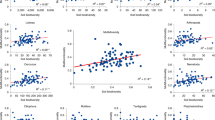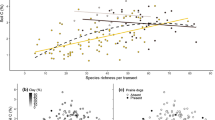Abstract
The results of soil ciliate frequency studies of 47 field studies, from 12 ecosystem types, were combined with recent concepts and observations to assess the importance of soil ciliate biodiversity in ecosystem functioning. A few species typically furnish most of the individuals; increases in biodiversity, produced by less common species, alters soil ciliate communities. Soil ciliates were grouped according to position on the r/K continuum, with polyhymenophoran species as K, and colpodids as r organisms; and according to degree of soil affinity. Grasslands and hardwood forests were characterized by large numbers of K and intermediate species, whereas pine forests and more stressed ecosystems (e.g., arable lands, deserts) had more colpodid and fewer total species. Within these systems, certain species may become prominent, or be absent, suggesting that many soil ciliates exhibit widely overlapping niches, and that while a soil might function with a few species, high diversity allows systems to respond to changing seasons and climate.
Similar content being viewed by others
References
Bamforth S S 1984 Microbial distributions in Arizona deserts and woodlands. Soil Biol. Biochem. 16, 133–137.
Bamforth S S 1985 The role of protozoa in litters and soils. J. Protozool. 32, 404–409.
Bamforth S S 1988 Interactions between protozoa and other organisms. Agric. Ecosystems Environ. 24, 229–234.
Bamforth S S 1991 Enumeration of soil ciliate active forms and cysts by a direct count method. Agric. Ecosystems Environ. 34, 209–212.
Bamforth S S and Bennett L W 1985 Soil protozoa of two Utah deserts. Pedobiologia 28, 423–426.
Buitkamp U 1977 Die Ciliatenfauna der Savanne von Lampto (Elfen-beinkuste). Acta Protozool. 16, 249–276.
Coleman D C, Reid C P and Cole C V 1983 Biological strategies of nutrient recycling in soil systems.In Advances in Ecological Research, 13. Eds. A MacFadyen and E O Ford. pp 3–54. Academic Press, NY.
Foissner W 1981 Die Gemeinschaftsstruktur der Ciliatenzonose in alpinen Boden (Hohe Tauern, Osterrich) und Grundlagen fur ein Synokologie der terricolen Ciliaten (Protozoa, Ciliophora). Veroff. Osterr. Mass-Programms 4, 7–52.
Foissner W 1987 Soil protozoa: Fundamental problems, ecological significance, adaptations in ciliates and testaceans, bioindicators, and guide to the literature. Prog. Protistol. 2, 29–212.
Foissner W 1992 Comparative studies on the soil life in ecofarmed and conventionally farmed fields and grasslands of Austria. Agric. Ecosystems Environ. 40, 207–218.
Freckman D W 1988 Bacterivorous nematodes and organic matter decomposition. Agric. Ecosystems Environ. 24, 195–217.
Lehle E 1992 Wimpertiere und andere Einzeller im Boden eines Fichtenbestandes im Schwartzwald. Mikrokosmos 81, 193–198.
Luftenegger G, Foissner W and Adam H 1985 r- and Kselection in soil ciliates: a field and experimental approach. Oecologia 66, 574–579.
Mueller J A and Mueller W P 1970Colpoda cucullus, a terrestrial aquatic. Am. Midl. Nat. 83, 1–12.
Ryan P G et al. 1989 Biological Survey of Robertskollen, western Dronning Maud Land: area description and preliminary species lists S. Afr. J. Antarct. Res. 19, 10–20.
Smith H G 1978 The distribution and ecology of terrestrial Protozoa of sub-Antarctic and maritime Antarctic islands. Br. Antarct. Surv. Sci. Rep. 95, 104.
Smith H G, Hughes J and Moore S J 1990 Growth of Antarctic and temperate terrestrial Protozoa under fluctuating temperature regimes. Antarct. Sci. 2, 313–320.
Wodarz D, Aescht E and Foissner W 1992 A weighted coenotic index (WCI): description and application to soil animal assemblages. Biol. Fertil. Soils 14, 5–13.
Yeates G W 1970 The diversity of soil nematode faunas. Pedobiologia 10, 104–107.
Yeates G W et al. 1991 Recolonization of methyl bromide sterilized soils under four different field conditions. Biol. Fertil. Soils 11, 181–189.
Author information
Authors and Affiliations
Rights and permissions
About this article
Cite this article
Bamforth, S.S. Interpreting soil ciliate biodiversity. Plant Soil 170, 159–164 (1995). https://doi.org/10.1007/BF02183064
Issue Date:
DOI: https://doi.org/10.1007/BF02183064




